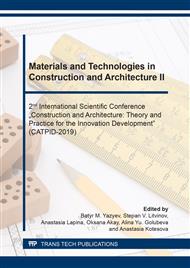[1]
S. A. Ambartsumyan, Elasticity theory of different moduli, Science, Moscow, (1982).
Google Scholar
[2]
A.N. Beskopylny, E.E. Kadomtseva, G.P. Strelnikov, Y.A. Berdnik, Stress-strain state of reinforced bimodulus beam on an elastic foundation, IOP Conf. Ser.: Earth Environ. Sci. 90 (2017) 012064.
DOI: 10.1088/1755-1315/90/1/012064
Google Scholar
[3]
A.N. Beskopylny, E.E. Kadomtseva, G.P. Strelnikov, Numerical study of the stress-strain state of reinforced plate on an elastic foundation by Bubnov-Galerkin method, IOP Conf. Ser.: Earth Environ. Sci. 90 (2017) 012017.
DOI: 10.1088/1755-1315/90/1/012017
Google Scholar
[4]
A. Zolochevsky, The formulation of constitutive equations for fibre-reinforced composites with different behaviour in tension and compression, Mechanics Research Communications. 23 (issue 1) (1996) 55-60.
DOI: 10.1016/0093-6413(95)00077-1
Google Scholar
[5]
A. N. Beskopylny, E. E. Kadomtseva, G. P. Strelnikov, Static analysis of a reinforced bimodulus beam on elastic foundation, MATEC Web of Conferences. 196 (2018) 02003.
DOI: 10.1051/matecconf/201819602003
Google Scholar
[6]
George Z. Voyiadjis, Alexander Zolochevsky, Thermodynamic modeling of creep damage in materials with different properties in tension and compression, International Journal of Solids and Structures. 37(issue 24) (2000) 3281-3303.
DOI: 10.1016/s0020-7683(99)00031-1
Google Scholar
[7]
M. E. Babeshko and Yu. N. Shevchenko, Elastoplastic stress-strain state of flexible layered shells made of isotropic and transversely isotropic materials with different moduli and subjected to axisymmetric loading, Int. Appl. Mech. 43(11) (2007) 1208–1217.
DOI: 10.1007/s10778-007-0124-5
Google Scholar
[8]
S.V. Litvinov, A.N. Beskopylny, L. Trush, S.B. Yazyev, Optimization of thick-walled spherical shells at thermal and power influences, MATEC Web of Conferences. 106 (2017) 04013.
DOI: 10.1051/matecconf/201710604013
Google Scholar
[9]
A.N. Beskopylny, A.A. Veremeenko, B.M. Yazyev Metal structure diagnosis by truncated cone indentation, MATEC Web of Conferences. 106 (2017) 04004.
DOI: 10.1051/matecconf/201710604004
Google Scholar
[10]
A.N. Beskopylny, A.A. Veremeenko, E.E. Kadomtseva, N.I. Beskopylnaia, Non-destructive test of steel structures by conical indentation, MATEC Web of Conferences 129 (2017) 02046.
DOI: 10.1051/matecconf/201712902046
Google Scholar
[11]
A. Beskopylny, A. Lyapin, V. Andreev, Layered structure mechanical properties assessment by dynamic tests, MATEC Web of Conferences. 117 (2017) 00018.
DOI: 10.1051/matecconf/201711700018
Google Scholar
[12]
A. Beskopylny, A. Lyapin, M. Kadomtsev, A. Veremeenko, Complex method of defects diagnostics in underground structures, MATEC Web of Conferences. 146 (2018) 02013.
DOI: 10.1051/matecconf/201814602013
Google Scholar


